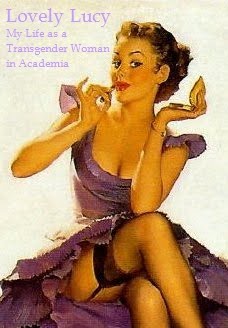

This afternoon, I was interviewed by the local radio program "Information Underground" about my experiences as a transsexual woman and the impact that has had on my life as a graduate student and instructor. The interview can be heard here Information Underground January 10, 2010. The interview should begin playing immediately and my segment begins at around the 19 minute point.
Above are a couple of pictures of the outfit I wore to the interview. A friend that I had dinner with later joked "You sure look nice for your radio interview."
I know I've discussed this before but I do like to look nice. It's really just my personal style, not anything to do with my feelings about gender roles or how other women should or should not dress. According to Claudine Griggs (1998) in S/he: Changing Sex and Changing Clothes, "MTFs seem to dress in extremes during their transitions, often wearing stereotypic and/or provocative fashions, overdressing for informal occassions, and wearing clothes that are too youthful for their age . . . Many MTFs seem to delight in ultra-feminine clothes during the early stages of transition" (p. 14-15). Griggs also discusses her own fashion choices during her transition, moving from a June Cleaver-esque "initiation stage" of dresses, heels and makeup to a "rebellion stage" of faded jeans, sweatshirts and drip-dried hair.
I may be in my own "initiation stage" where I'm just so happy to be able to dress how I want, but I feel that too often people try to make to many generalizations about what being transsexual means. Just because one transsexual chooses to dress in a feminine style doesn't mean that every transsexual has to dress in a feminine style; likewise, just because dressing in a feminine style was for one transsexual just a stage in her development as a woman doesn't mean that it will be that way for every transsexual.
Above are a couple of pictures of the outfit I wore to the interview. A friend that I had dinner with later joked "You sure look nice for your radio interview."
I know I've discussed this before but I do like to look nice. It's really just my personal style, not anything to do with my feelings about gender roles or how other women should or should not dress. According to Claudine Griggs (1998) in S/he: Changing Sex and Changing Clothes, "MTFs seem to dress in extremes during their transitions, often wearing stereotypic and/or provocative fashions, overdressing for informal occassions, and wearing clothes that are too youthful for their age . . . Many MTFs seem to delight in ultra-feminine clothes during the early stages of transition" (p. 14-15). Griggs also discusses her own fashion choices during her transition, moving from a June Cleaver-esque "initiation stage" of dresses, heels and makeup to a "rebellion stage" of faded jeans, sweatshirts and drip-dried hair.
I may be in my own "initiation stage" where I'm just so happy to be able to dress how I want, but I feel that too often people try to make to many generalizations about what being transsexual means. Just because one transsexual chooses to dress in a feminine style doesn't mean that every transsexual has to dress in a feminine style; likewise, just because dressing in a feminine style was for one transsexual just a stage in her development as a woman doesn't mean that it will be that way for every transsexual.
I guess only time will tell what it will be for me.

